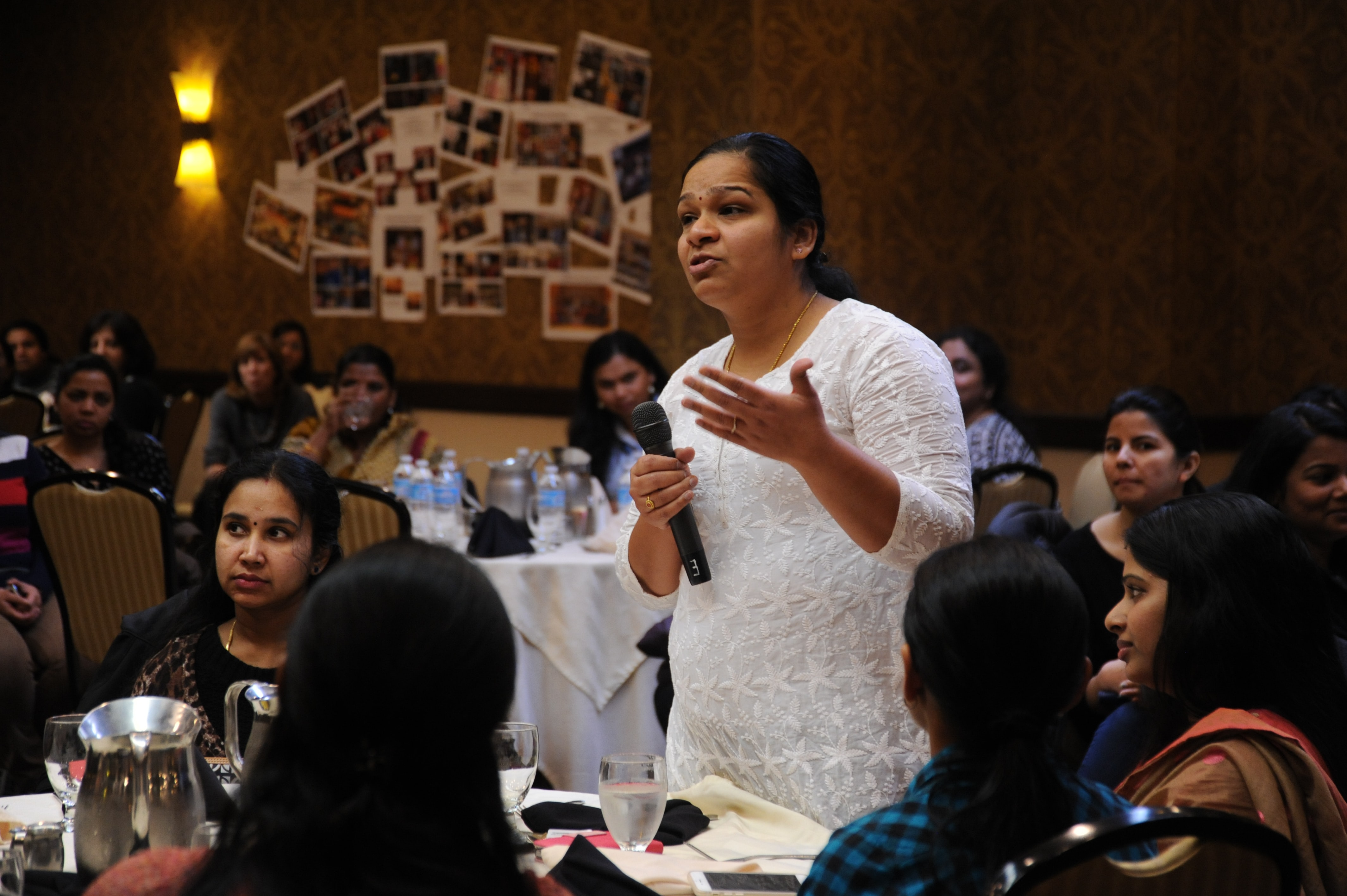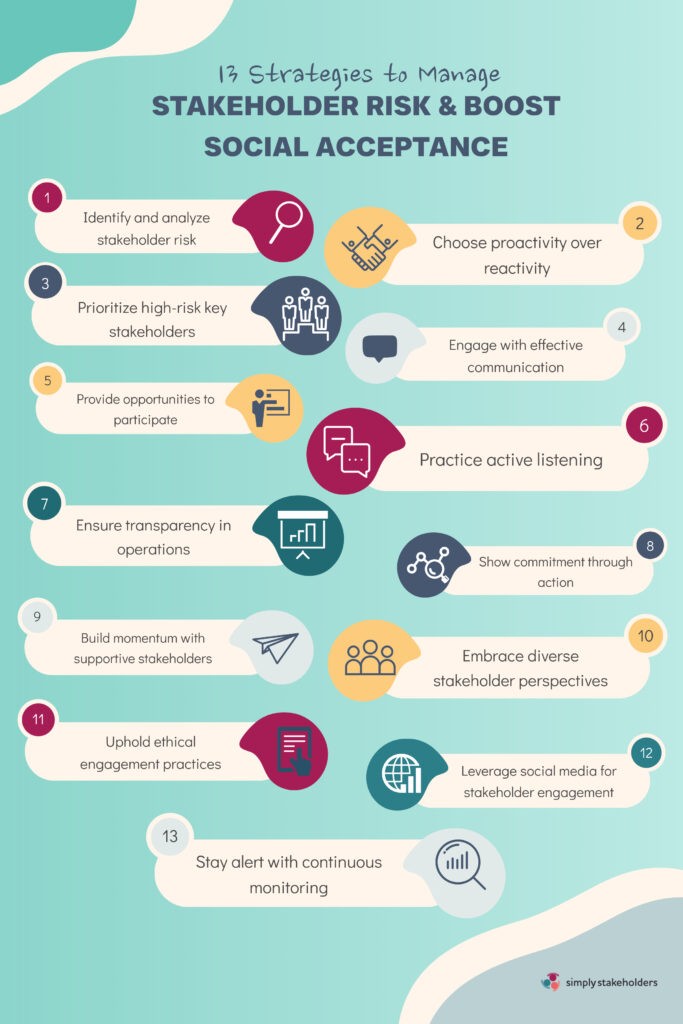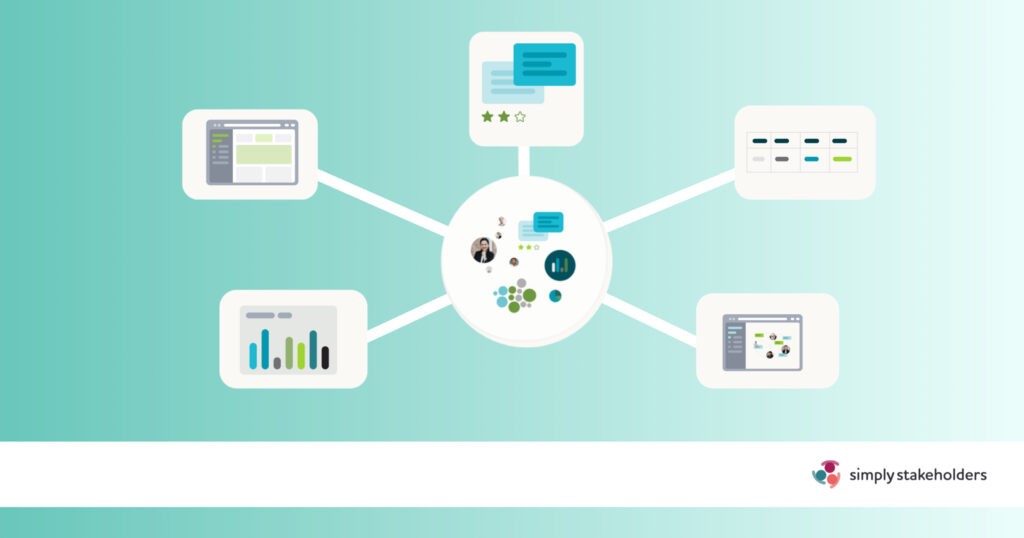Managing Stakeholder Risk & Social Acceptance

There’s a side to stakeholder management that we haven’t talked about much until now…
We have talked a lot about stakeholder and risk in the sense that engaging with and managing stakeholders can help to reduce an organization’s risk because you have better relationships and more information to work with.
But today we want to focus on the idea that some stakeholders themselves may present a risk to your project or organization. And if you don’t gain their social acceptance, you could face significant challenges ahead.
So, let’s dive into how you can manage stakeholder risk and increase your chances of acceptance. But before we get into risk management, let’s lay the foundations with some research on the psychology of stakeholder decisions, and how you might be able to identify higher risk stakeholders.
Understanding the Psychology of Stakeholder Decisions
To better understand why some stakeholders might present greater risk than others, it’s worth digging into the psychological aspects behind stakeholder decisions.
What drives some stakeholders to oppose your project, rally others to their cause, and create conflict? Here’s some of the factors that influence decisions, according to the research:
- Cognitive Biases – These common, systematic errors in thinking can lead to irrational decision-making and may include anchoring bias (relying too heavily on the first piece of information encountered), confirmation bias (seeking out information that confirms pre-existing beliefs), and availability bias (relying too much on information that’s readily available).
- Emotional Factors – The way someone feels tends to influence their choices, including emotions like greedy, fearful, regretful, sympathetic, hopeful, safe, trusting, happy, disappointed, stressed, sad, or angry.
- Social Influences – The behavior of others and social norms can influence stakeholder behavior and decisions.
- Stakeholder Interests – In addition, many stakeholders will be motivated by their specific interests and what they stand to gain or lose by the project. This might include economic interests, social interests, intellectual interest, academic interest, or environmental interests.
By understanding this context, you can take a more strategic, psychologically-aware approach to managing your stakeholders and their potential risk. We’ll get into some of these strategies later on in this guide.
Identifying High-Risk Stakeholders

Technically, any stakeholder could be considered a risk to your project or business these days. People have a lot more power to influence than they used to, thanks to social media and the ability to rally people to their opinion and cause.
But it’s fair to say that some stakeholders still hold more power and influence than others — and are more likely to cause problems for projects they’re opposed to. Their social acceptance could mean the difference between a project that goes ahead and one that falls apart.
Examples of higher risk stakeholders include:
- Public Critics: Especially if they share their opinions publicly and influence others, this could lead to a loss of reputation, poor publicity, and loss of customers/clients.
- Legally Empowered Stakeholders: Some stakeholders may have the power to pursue legal action or push for regulatory changes that impact your organization or project.
- Interest-Conflicted Stakeholders: If certain stakeholders aren’t fully onboard with your project or organization due to conflicting interests, they might cause delays, performance issues, and relationship problems. For example, interest-conflicted stakeholders could include lobby groups with conflicting agendas and your politically motivated opposition.
- Cybersecurity Risks: Stakeholders presenting a security risk – Cybersecurity in particular is a huge concern right now, and in some cases, stakeholders might present an additional vulnerability to your organization that could introduce malware or lead to a data breach.
- Supply Chain Disruptors: Stakeholders that form part of your supply chain could risk disrupting your operations and causing loss of reputation or poor financial outcomes.
It’s also worth considering that some stakeholders may present a risk to more than just your project or organization. For example, in industries like mining, oil, and gas, as well as larger infrastructure projects, operations can have a substantial impact on local communities. And you may need to undergo an environmental risk management process or social risk management measures if you identify that some of your stakeholders (suppliers, partners, and employees) could pose a risk to the environment or society — which could have a flow-on effect to your organization.
13 Strategies to Manage Stakeholder Risk & Increase Social Acceptance

So, what can you do to better target and manage these riskier stakeholders? Here are 13 strategies and approaches that can help you hone your risk management process.
1. Identify and Analyze Stakeholder Risk
First, you need to know who your stakeholders are, including both internal stakeholders and external stakeholders. From there, you can start to understand the situation from their perspective, who your riskiest stakeholders are, and who you need to prioritize first.
Stakeholder analysis and stakeholder mapping can help you identify primary stakeholders, secondary stakeholders, and key stakeholders based on interest, influence, and impact. And sentiment analysis can help you identify stakeholders who feel negatively about your project, organization, or issue — which may indicate greater risk of opposition and lower social acceptance. Meanwhile, relationship mapping can also help you identify influential or powerful people to focus on who may help you gain broader social acceptance once you win them over.
Overall, identifying your stakeholders, analyzing them, and understanding their needs and interests will help you tailor your approach, which will prove helpful for gaining social acceptance.
2. Choose Proactivity Over Reactivity
With risk management, it’s always best to avoid or resolve risk by doing the work ahead of time — and if you can’t avoid it, put measures in place to mitigate the risk. You should choose proactivity over reactivity when it comes to high risk stakeholder relationships. This means:
- Don’t wait for something or someone to become a problem
- Communicating early and often
- Identifying potential risks early — and developing strategies to mitigate them
- Anticipating issues that stakeholders might have and bring them up early on
- Trying to solve problems before they become big enough to derail your project or relationships
3. Prioritize High-Risk Key Stakeholders
It’s always a good idea to build relationships with stakeholders, but pay special attention to those relationships that pose a higher risk. Keeping these people close can help you manage and reduce the associated risks.
Some ways to improve your relationships with higher risk stakeholders include:
- Carefully listening to stakeholder concerns
- Responding to their questions and comments quickly
- Building trust through integrity, consistency, and transparency
- Finding mutual interests and building shared understanding
- Developing mutual respect
By building a strong relationship with the right people, you can establish yourself in the community and (hopefully) gain rapid traction. And increase the likelihood that even your highest risk stakeholders see you as partners instead of opponents.
4. Engage with Effective Communication
Good communication is part of stakeholder management, but it’s especially key to engaging with higher risk stakeholders. Come back to your stakeholder analysis so that you:
- Understand the issues to focus on (and address their concerns)
- Engage in a way that meets their expectations
- Align with their communication preferences
In general, it’s best to communicate regularly and consistently to avoid surprising people with an unexpected update. Keep people informed on your plans, activities, progress, reports, and any opportunities for stakeholder involvement — while managing their expectations.
Other general best practices for good stakeholder communication include using multiple communication channels (to reach more people), considering accessibility and inclusion, and using clear, concise language.
5. Provide Opportunities to Participate
One way to increase social acceptance and buy-in from key people is to offer more opportunities for them to participate. Some methods of stakeholder involvement could include:
- Surveys
- Focus groups
- Meetings
- Events
- Volunteering
Any opportunity to share ideas, offer feedback, or provide skills can help to get your stakeholders involved. Just make sure that their participation is meaningful — feedback should be heard and have the opportunity to impact outcomes, so don’t ask for input on things that cannot be changed.
6. Practice Active Listening
Effective listening is always important, but especially when a stakeholder could present additional risk. This involves addressing any concerns and complaints promptly and effectively, showing that you’re listening and willing to take action. A welcome side-effect of listening to your stakeholders is that they might be more open to hearing your side of the story, too. And this could lead to them accepting new information and perspectives that help to change their mind or find a compromise.
7. Ensure Transparency in Operations
Although we’ve already touched on this concept, transparency deserves further consideration because it shows stakeholders that your organization can be trusted — even if they don’t exactly agree with your decisions.
One good way to increase transparency is by regularly communicating about your progress and process via reports and other channels. In your reports, be open about your governance, social responsibility, human rights issues, sustainability, and other key issues.
8. Show Commitment Through Action
It’s one thing to say you’re committed to doing good… but are you actually doing what you say you’ll do?
Demonstrating commitment can help you manage stakeholder risk and gain social acceptance from even some of your more difficult stakeholders. So, take action and report on what you’re doing to meet your commitments as a socially responsible organization, including sustainability, ethical business practices, environmental protection, community engagement, human rights, and more.
9. Build Momentum With Supportive Stakeholders
Use the stakeholder analysis process to identify stakeholders that likely support the work you are doing and consider building relationships with them first. In some cases, these initial relationships with lower risk stakeholders can help you demonstrate social acceptance and legitimacy, which may help you win over more challenging stakeholders.
10. Embrace Diverse Stakeholder Perspectives
Try to gather feedback on your project from a broad range of stakeholder groups, across a variety of backgrounds — including groups who may not usually have a say due to cultural differences, disability, and other barriers to access. Use stakeholder mapping and analysis to identify all your stakeholder groups and ensure proper representation, including marginalized voices.
By embracing diverse stakeholder perspectives, you’ll benefit from:
- More comprehensive risk identification
- More innovative problem-solving
- More inclusive processes that build trust and credibility
- More robust, well-rounded solutions
- Better decisions based on more complete information
- More socially responsible outcomes
11. Uphold Ethical Engagement Practices
Undertaking an ethical engagement process isn’t just the right thing to do — it can help you reduce project risks and increase stakeholder acceptance. An ethical approach can help to build trust, improve your organization’s reputation, ensure you comply with legal requirements, gain a social license, and build better relationships with your stakeholders.
Consider how you can incorporate the following ethical engagement practices as part of your stakeholder risk management process:
- Communicating information clearly
- Being honest and transparent about any impacts
- Disclosing any conflicts of interest
- Outlining the decision-making process, including how the engagement can and can’t impact outcomes
- Respecting human rights, cultural traditions, local customs, and the rights of indigenous groups
- Providing opportunities for all impacted stakeholder groups to participate
- Actively working to include marginalized or vulnerable groups that may not be able to access or feel comfortable with traditional engagement methods
- Ensuring stakeholder data security is maintained, and appropriate privacy measures are taken
- Meeting all your commitments to stakeholders
- Working to build social capital and leave the community with more capacity and stronger relationships
- Reporting back to stakeholders on the engagement and any actions taken
12. Leverage Social Media for Stakeholder Engagement
With most stakeholders now active on social media, being present on social media platforms presents both opportunities and risks for organizations.
Regardless of whether your organization chooses to show up on social media, there’s the risk that stakeholders will share their negative opinions and experiences publicly, which could lead to brand damage and even sway the opinions of other stakeholders.
Meanwhile, being present on social media means stakeholders will expect ongoing monitoring and timely responses to their comments and questions across the platforms you’re on — in addition to any existing channels.
That said, being on social media brings opportunities, like:
- Sharing information and updates
- Reaching a larger audience
- Strengthening relationships
- Communicating directly with stakeholders
- Leading the conversation
- Responding to positive and negative comments
- Brand building
- Making participation more accessible to stakeholders who might not use traditional feedback platforms
- Tapping into user-generated content
Overall, effectively leveraging social media in your stakeholder engagement can help you increase visibility and acceptance for your project, while allowing you to step in when stakeholders use social media to express a complaint or grievance.
13. Stay Alert with Continuous Monitoring
Finally, it’s always important to track your stakeholders, but even more so when you’re dealing with higher risk scenarios. Use stakeholder monitoring software like Simply Stakeholders to keep track of all your stakeholder contacts and interactions — Asana and Spreadsheets won’t cut it. Careful monitoring will help you (and your team) stay on top of issues, grievances, trends, and which stakeholders need to reach out to next.
The Role of Digital Tools in Managing Stakeholder Risk

Of course, one of the best ways to stay on top of stakeholder risk management is with modern digital tools that help you track your stakeholders, analyze your stakeholder data, and determine what actions you need to take and when.
Popular tools include:
- Spreadsheets – A good place to start for smaller organizations and engagement to record their information when engaging stakeholders.
- CRM systems – While customer relationship management systems aren’t built for stakeholder processes, they can be used for basic relationship tracking.
- Relationship management software – Stakeholder relationship management software (SRMs) can allow you to track and manage your relationships with stakeholders.
- Feedback tools – Tools like survey software or polls can allow you to gather insights into your stakeholders, what they think, and what issues they care about.
- Engagement sites – Create a dedicated place for information on your project and consultation with an engagement hub or website.
But the gold standard stakeholder engagement tool is a platform that includes a comprehensive range of tools to manage your stakeholders and make sense of your data — so that you can identify risk early and take action on it.
Look for stakeholder management software that includes a stakeholder contact register, stakeholder mapping and analysis, relationship tracking, issues tagging, reporting, complaints, collaboration, and alerts. Simply Stakeholders includes all of these tools and more — making it ideal for managing stakeholder risk.
Stakeholder Risk Management Simplified with Simply Stakeholders
Need a tool to track and manage your stakeholders — and better understand their unique risk profiles and social acceptance? You need Simply Stakeholders.
With flexible stakeholder lists, advanced stakeholder mapping and analysis, and detailed record keeping… our stakeholder software makes even the trickiest stakeholder management processes a whole lot simpler.
Contact us with your questions or request a demo from our team today!






























